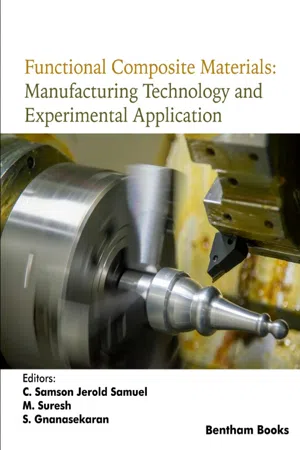
Functional Composite Materials: Manufacturing Technology and Experimental Application
- English
- ePUB (mobile friendly)
- Available on iOS & Android
Functional Composite Materials: Manufacturing Technology and Experimental Application
About This Book
This book highlights the advancements in the manufacture and testing of functional composites, metal matrix composites and polymer matrix composites. Chapters provide information about machinability studies of metals and composites using a variety of analytical techniques. The 12 book chapters also highlight updates in manufacturing technologies like CNC turning processes, electrical discharge machining, end milling, abrasive jet machining, electro chemical machining, additive manufacturing, and resistance spot welding. Readers will learn how to solve applied problems in industrial processing and applications. The book is of significant interest to industrialists working on the basic and experimental parameters for fabricating functional composites and manufacturing technology. Because of the multidisciplinary nature of the presented topics, the information presented in the book is of value to a broad audience involved in research, including materials scientists, chemists, physicists, manufacturing and chemical engineers and processing specialists who are involved and interested in the frontiers of composite materials.
Frequently asked questions
Information
Optimization of Machining Process Parameters to Calculate Surface Finish, Metal Removal Rate, and Cutting Force on AA6061-T6 Alloy
Karthik Pandiyan G.1, *, T. Prabaharan2, Jafrey Daniel James D.3
Abstract
* Corresponding author Karthik Pandiyan G.: Department of Mechanical Engineering, Sri Vidya College of Engineering and Technology, Virudhunagar, Tamil Nadu, India; E-mail: [email protected]
INTRODUCTION
Table of contents
- Welcome
- Table of Content
- Title
- BENTHAM SCIENCE PUBLISHERS LTD.
- FOREWORD
- PREFACE
- List of Contributors
- Optimization of Machining Process Parameters to Calculate Surface Finish, Metal Removal Rate, and Cutting Force on AA6061-T6 Alloy
- Machinability Analysis and Optimization by the Taguchi-gra-pca Approach of PMEDM Process Parameters of Monel K 500
- Analyzing the Influence of RSW Process Parameters on the Cross Tension Failure Load of Dissimilar functionally graded AISI 304/316L Stainless Steel Sheets
- A Review on Manufacturing of Aluminium Alloy Based Metal Matrix Composites through Stir Casting Route
- Experimental Analysis of Different Machining Parameters on Epoxy Granite Composite
- Analysis on Synthesized Carbon Aerogels Doped with Resorcinol Formaldehyde by XPS and Fesem Techniques
- Tribological Behaviour of Hybrid Natural Fiber Polymer Composites with Novel Fillers
- Application of Natural Fiber-reinforced Composites in Additive Manufacturing
- Investigation of Ionic Transport in Ionic Liquid BMIMBF4 Incorporated in ZnBDC-Metal-Organic Framework Based PVdF-HFP Composite Membranes
- Manufacturing Techniques and Applications of Multifunctional Metal Matrix Composites
- Machining Studies of Basalt Fiber Reinforced Aluminium Metal Matrix Composites Using Abrasive Jet Machining
- Multi-objective Optimization on Processing Parameters for Micro ECM of Inconel Alloy Using Taguchi Based Grey Relation Analysis